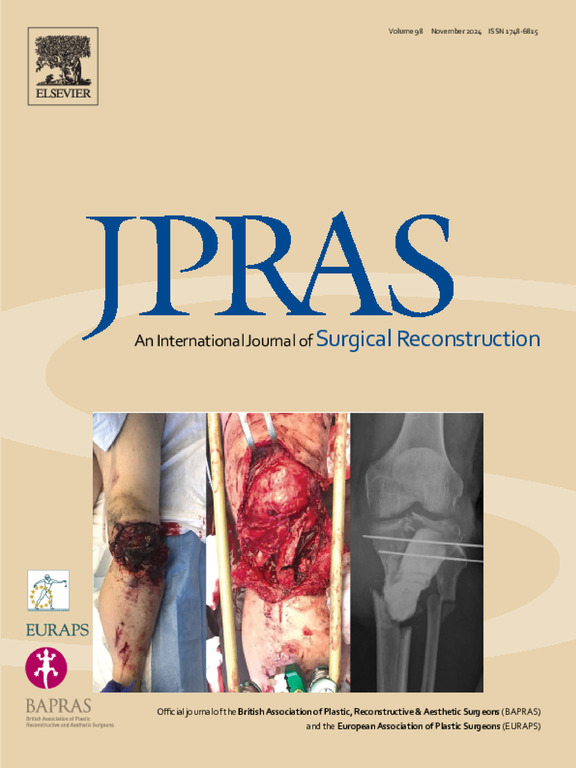Bilateral Cleft Lip Severity Index in primary cleft rhinoplasty: Correlation with anthropometric outcomes and layperson perception
IF 2.4
3区 医学
Q2 SURGERY
Journal of Plastic Reconstructive and Aesthetic Surgery
Pub Date : 2025-07-07
DOI:10.1016/j.bjps.2025.06.044
引用次数: 0
Abstract
Background
The Bilateral Cleft Lip Severity Index (BCLSI) was developed to predict outcomes among patients who underwent bilateral cleft lip (CL) repair. However, its utility among cleft patients undergoing bilateral repair with primary rhinoplasty (PR) has not been studied. Here, we assess whether the BCLSI predicts nasal anthropometric and aesthetic outcomes in patients who had PR at the time of bilateral CL repair.
Methods
A retrospective review was performed of all children who underwent bilateral CL repair from 2008 to 2023 at our institution. Preoperative photographs were graded using the BCLSI (grades 1–3, 1 being least severe) and anthropometric analyses performed. Crowdsourcing surveys utilized pairwise comparison or Likert scale ratings of nasal appearance.
Results
55 patients met inclusion criteria and were stratified by BCLSI severity: Grade 1, 11 (20.0%); Grade 2, 17 (30.9%); and Grade 3, 27 (49.1%). Postoperative columellar-labial angle (CLA) was 117.7°±8.8°, 127.3°±9.6°, 133.4°±12.4° in patients with BCLSI of 1, 2, and 3, respectively (p<0.001). Patients with BCLSI 1 received the most favorable layperson evaluations, while those with BCLSI 3 received the least favorable assessments across pairwise rank-derived coefficients (p=0.017) and composite ratings (p=0.014) independent of age of surgery, history of nasoalveolar molding, and technique. Greater CLA correlated with less favorable pairwise ratings (p=0.018).
Conclusions
Among patients undergoing bilateral CL repair with PR, higher BCLSI was associated with greater columellar-labial angle and worse nasal appearance scores postoperatively. Overall, the BCLSI may be a clinically useful tool with prognostic relevance for patients undergoing bilateral cleft repair both with and without primary rhinoplasty.
初次鼻裂成形术的双侧唇裂严重指数:与人体测量结果和外行人感知的相关性
研究背景:双侧唇裂严重指数(BCLSI)用于预测双侧唇裂修复患者的预后。然而,其在接受双侧修复术(PR)的唇裂患者中的应用尚未研究。在这里,我们评估BCLSI是否预测双侧CL修复时PR患者的鼻人体测量和美学结果。方法回顾性分析2008年至2023年在我院行双侧CL修复术的患儿。术前照片采用BCLSI评分(1 - 3级,1级为最不严重),并进行人体测量分析。众包调查采用两两比较或李克特量表评定鼻腔外观。结果55例患者符合纳入标准,按BCLSI严重程度分层:1级、11级(20.0%);2年级17人(30.9%);3年级27人(49.1%)。BCLSI为1、2、3的患者术后小柱-唇角(CLA)分别为117.7°±8.8°、127.3°±9.6°、133.4°±12.4°(p<0.001)。BCLSI 1型患者获得了最有利的外行人评价,而BCLSI 3型患者获得了最不利的评价,其两两秩衍生系数(p=0.017)和综合评分(p=0.014)与手术年龄、鼻槽成型史和技术无关。较大的CLA与较差的两两评分相关(p=0.018)。结论在双侧CL修复术患者中,BCLSI越高,术后小柱-唇角越大,鼻外观评分越差。总的来说,BCLSI可能是一种临床有用的工具,对接受双侧腭裂修复的患者的预后有相关性,无论是否进行初次鼻整形。
本文章由计算机程序翻译,如有差异,请以英文原文为准。
求助全文
约1分钟内获得全文
求助全文
来源期刊
CiteScore
3.10
自引率
11.10%
发文量
578
审稿时长
3.5 months
期刊介绍:
JPRAS An International Journal of Surgical Reconstruction is one of the world''s leading international journals, covering all the reconstructive and aesthetic aspects of plastic surgery.
The journal presents the latest surgical procedures with audit and outcome studies of new and established techniques in plastic surgery including: cleft lip and palate and other heads and neck surgery, hand surgery, lower limb trauma, burns, skin cancer, breast surgery and aesthetic surgery.

 求助内容:
求助内容: 应助结果提醒方式:
应助结果提醒方式:


